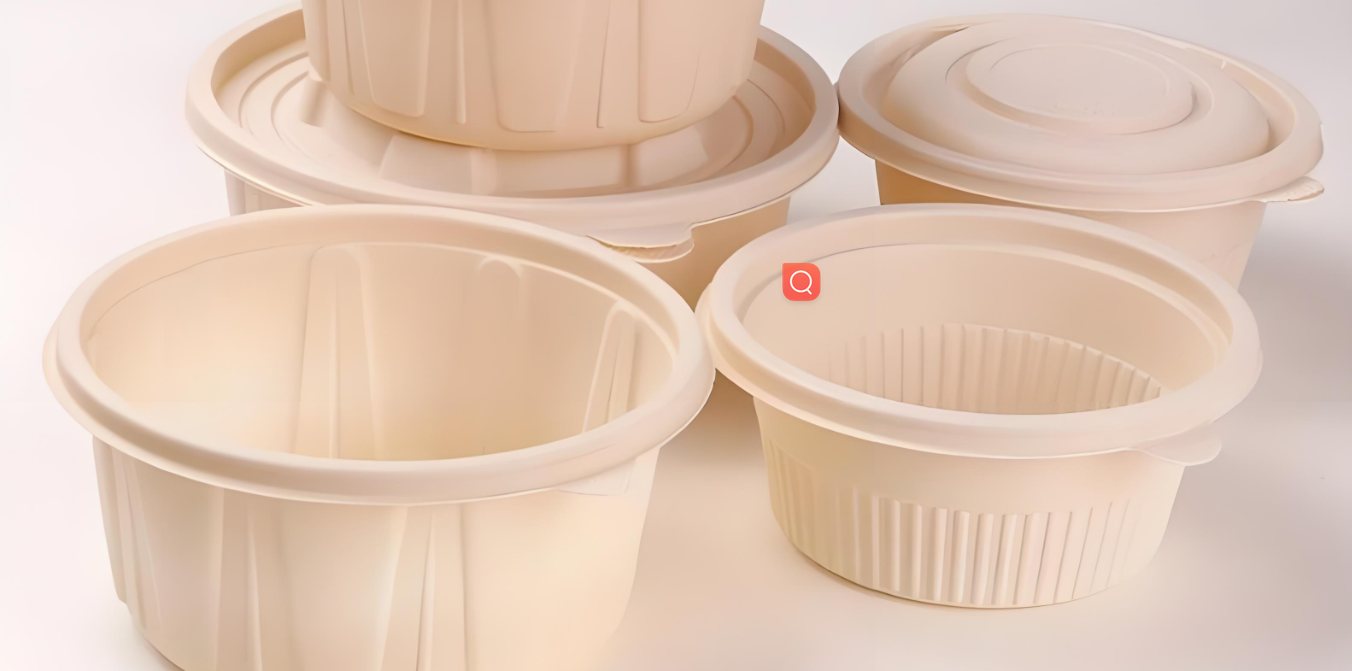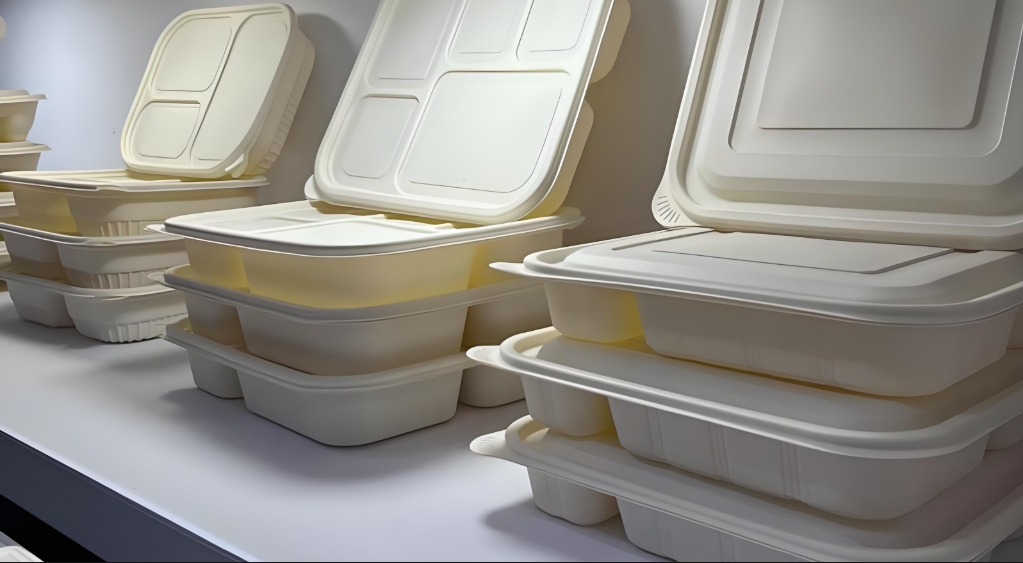Introduction to Cornstarch containers
Cornstarch containers are made from corn starch-based polylactic acid (PLA). I find them to be a smart choice for green packaging. More companies now choose these containers as a practical green option instead of regular plastic ones.
What Makes Cornstarch containers Unique?
Cornstarch containers stand out for their remarkable biodegradability, completely breaking down through natural processes and being suitable for composting. In industrial composting facilities, they decompose entirely within just 90-180 days, representing a significant environmental advantage.
The foundation of these containers is corn, a renewable and sustainable crop cultivated worldwide. This agricultural base creates a compelling alternative to traditional petroleum-based plastics, offering a more environmentally responsible solution.
Additionally, cornstarch containers contain no harmful chemicals such as BPA, making them inherently safer for both human health and environmental systems. This chemical-free composition aligns perfectly with contemporary health regulations and ecological standards, further enhancing their appeal as a sustainable packaging solution.
How Are Cornstarch containers Manufactured?
The production of cornstarch containers begins with corn kernels, which undergo processing to extract pure starch through the removal of protein and fiber components. This starch is then converted into simple sugars through fermentation processes.
These sugars are transformed into lactic acid, which subsequently forms polylactic acid (PLA) – the foundation of the bioplastic material. Manufacturers then melt the PLA and form it into small, uniform pieces that serve as the raw material for the final product.
Using injection molding technology, these PLA pieces are shaped into finished containers. This streamlined manufacturing process ensures consistent quality while producing versatile containers suitable for diverse business applications across multiple industries.
I believe cornstarch containers show how companies can use green materials. They help balance caring for our planet with running an efficient business.
Composition of Cornstarch containers
Cornstarch containers are made from polylactic acid (PLA), a plant-based plastic that comes from fermented corn starch. Their makeup and production create a green option instead of regular plastics.
Evaluating Cornstarch containers for Your Business
When considering cornstarch containers, assess their environmental benefits first. These biodegradable alternatives reduce carbon footprints and may qualify for eco-certifications that enhance your brand image with sustainability-focused consumers. Though initially more expensive than conventional options, calculate potential savings on disposal fees and regulatory compliance costs. Cost efficiencies can be achieved through bulk purchasing and local sourcing arrangements.
Performance remains critical—verify that cornstarch containers provide adequate load capacity and appropriate resistance to moisture and temperature variations for your specific products. Be aware of potential limitations in high-humidity environments or extended storage situations where biodegradability could affect longevity. Market trends increasingly favor sustainable packaging, with research showing many consumers willing to pay more for environmentally responsible options.
Regulatory compliance becomes simpler with biodegradable alternatives as legislation increasingly restricts conventional plastics. Ensure your chosen cornstarch containers meet composting standards across all your distribution markets. By evaluating these environmental, financial, performance and regulatory factors, you can determine whether cornstarch containers align with your operational needs and business strategy.
Environmental Impact
Biodegradability and Decomposition
Cornstarch packaging breaks down within 90 days in industrial composting settings. It stays in landfills for much less time than oil-based plastics. But wrong disposal is still a problem. When cornstarch packs end up in landfills, they release methane—a harmful greenhouse gas—as they decay.
Greenhouse Gas Emissions
Cornstarch bioplastics create 68% less greenhouse gas and use 65% less energy to make than regular oil-based plastics. Studies show a 25% cut in greenhouse gases when using cornstarch-based PLA instead of traditional plastics. I find this makes cornstarch packaging a greener choice during making and use.
Renewable Resources
Cornstarch packaging comes from corn, which farmers can grow again and again. This cuts down on using up fossil fuels. Corn grows well in many places, and we use just a small part of the world’s corn for bioplastics, showing we can make more. I must point out that growing corn does raise some concerns like soil health issues, cutting down forests, and pollution from fertilizers. These are areas we need to fix.
Carbon Footprint
Cornstarch-based items leave a smaller carbon footprint because they need less energy to make and don’t need toxic chemicals. Good waste handling makes cornstarch packaging even more earth-friendly. In the right conditions, thrown-away materials break down into natural parts like carbon dioxide and water in just months. This leaves little impact on our planet at the end of their use.
Cost-Effectiveness of Cornstarch Packaging
When evaluating cornstarch packaging economics, several factors influence the overall financial picture. Raw material costs depend on agricultural variables including harvest yields and supply chain efficiency. Since cornstarch derives from renewable corn crops, prices fluctuate seasonally and annually, requiring businesses to monitor agricultural markets to optimize procurement timing and manage cost predictability.
The transition to cornstarch packaging typically requires significant capital investment, with companies needing to allocate approximately 15-20% of their initial budget toward specialized equipment, technology implementation, and regulatory compliance. While this represents a substantial upfront commitment—particularly challenging for small enterprises—production expenses have decreased through technological advancements. Current manufacturing costs approximately $1 per unit, which still exceeds conventional plastic alternatives despite recent improvements. Additionally, ongoing research and development investments ranging from $200,000 to $500,000 annually help companies improve production efficiency and expand market opportunities.
A comprehensive cost analysis should balance immediate financial considerations against long-term strategic benefits, including brand differentiation, regulatory compliance, and alignment with growing consumer preference for sustainable packaging solutions. This holistic approach helps determine whether cornstarch packaging represents a financially viable option that supports both budgetary requirements and environmental objectives.
Customer Perception of Cornstarch Packaging
Adopting cornstarch packaging significantly elevates brand image by demonstrating authentic environmental commitment. Eco-conscious consumers increasingly favor such brands, forming stronger loyalty bonds based on shared values. This sustainable choice builds fundamental trust that extends beyond environmentalism to shape overall brand perception.
Consumer expectations for cornstarch packaging span multiple requirements. Functionally, buyers demand reliable product protection throughout distribution channels. Aesthetically, appealing designs that clearly communicate environmental benefits remain important. Transparency in materials sourcing and environmental claims has become essential, with clear labeling about composition and disposal options directly influencing purchasing decisions. Biodegradability has emerged as a particularly compelling feature as consumers actively seek solutions that minimize persistent waste.
These preferences manifest differently across industries. Food businesses see strong adoption for fresh produce, snacks, and takeout containers, where customers value both food safety and environmental responsibility. Apparel brands utilize resealable cornstarch bags to enhance perception while protecting merchandise. Events increasingly feature cornstarch plates and utensils, improving guest experiences while demonstrating environmental commitment.
Cornstarch packaging aligns perfectly with evolving ethical consumption patterns, offering tangible evidence of environmental responsibility through practical solutions. This allows brands to strengthen customer relationships and attract value-driven consumers who increasingly base purchasing decisions on sustainability credentials alongside traditional factors like price and quality.





